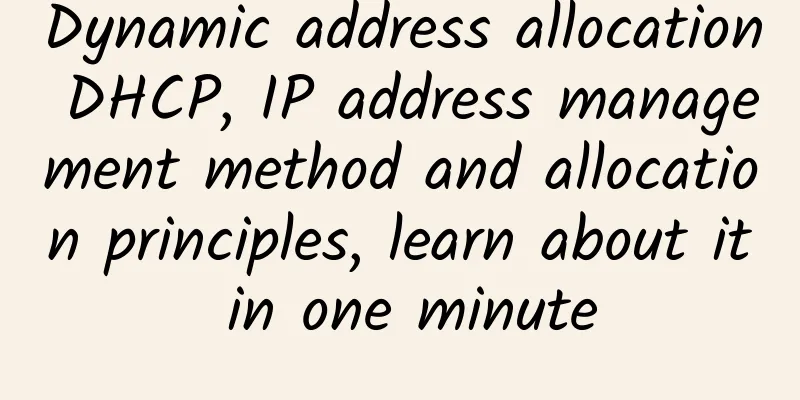Dynamic address allocation DHCP, IP address management method and allocation principles, learn about it in one minute

|
1. Introduction to DHCP DHCP (Dynamic Host Configuration Protocol) is used to dynamically allocate network configuration parameters such as IP addresses to network devices. DHCP uses a client/server communication model, where the client submits an application to the server to request the allocation of network configuration parameters, and the server returns configuration information such as the IP address allocated to the client to achieve dynamic configuration of information such as the IP address. In a typical DHCP application, there is usually a DHCP server and multiple clients (such as PCs and laptops). 2. DHCP IP address allocation 1. IP address allocation strategy In response to different needs of clients, DHCP provides three IP address allocation strategies:
2. IP address acquisition process The DHCP client obtains an IP address from the DHCP server in four stages:
After receiving the DHCP-ACK message from the server, the client will broadcast a free ARP message to detect whether there is a host using the IP address assigned by the server. If no response is received within the specified time, the client will use this address. Otherwise, the client will send a DHCP-DECLINE message to the DHCP server and re-apply for an IP address. If there are multiple DHCP servers in the network, in addition to the server selected by the DHCP client, the IP addresses not allocated this time in other DHCP servers can still be allocated to other clients. 3. IP address lease renewal The IP address assigned by the DHCP server to the client has a certain lease period (except for the automatically assigned IP address), which is called a lease. When the lease expires, the server will reclaim the IP address. If the DHCP client wants to continue using the address, it needs to apply for an extension of the IP address lease. When the IP address lease of the DHCP client reaches about half of the time, the DHCP client will unicast a DHCP-REQUEST message to the DHCP server that assigned the IP address to it to renew the IP lease. If the client can continue to use this IP address, the DHCP server responds with a DHCP-ACK message to inform the DHCP client that a new IP lease has been obtained; if this IP address can no longer be assigned to the client, the DHCP server responds with a DHCP-NAK message to inform the DHCP client that it cannot obtain a new lease. If the renewal operation fails at about half of the lease time, the DHCP client will broadcast a DHCP-REQUEST message to renew the lease when the lease period reaches 7/8. |
<<: G Suite vs. Office 365: Which is the right productivity suite for your business?
>>: Domain name www, to have or not to have, that is the question
Recommend
Impinj Releases Advanced RAIN RFID Chip, Unlocking New Opportunities for IoT Devices
Impinj, Inc. (NASDAQ: PI), a leading RAIN RFID pr...
Huawei fully supports Chinese operators in building China's 5G
This morning, the Ministry of Industry and Inform...
Are operators “breaking away from” the old ways? 2G/3G networks will eventually leave the stage
Recently, China Telecom Yunnan Company (Yunnan Te...
How to improve WiFi quality without increasing budget? 6 tips to improve enterprise LAN WiFi performance
Assuming your company has no funds for upgrading ...
CMIVPS: 20% off for monthly payment and 30% off for half-year payment for all VPS hosts, 5-100Mbps bandwidth for direct connection to Hong Kong
CMIVPS sent a promotional plan for this month, wi...
How is HostYun? Simple test of HostYun Hong Kong EQ-CMI line VPS
There is no discount information, so continue tes...
Animation explains TCP. If you still don’t understand, please hit me up
Preface The TCP three-way handshake process is a ...
Stay at home and have fun during the Spring Festival without worrying about WiFi.
Many of my friends stayed at home during the Spri...
5G keeps refreshing the timetable and the three major operators have finalized the roadmap!
5G has been constantly updating its timetable rec...
Some thoughts on the information construction of the financial industry
The rapid development of information technology h...
Report: 5G conspiracy theories caused 170,000 hours of downtime in UK base stations
UK regulator Ofcom has revealed that so far in 20...
CAICT answers hot issues on “number portability” service
On November 27, 2019, China Telecom, China Mobile...
EMR on ACK is newly released to help enterprises efficiently build big data platforms
Alibaba Cloud EMR on ACK provides users with a ne...
DCI has won the "China IT Operation and Maintenance Best Solution Award" and "China IT Operation and Maintenance Best Product Award" for eight consecutive years.
At the 2018 China IT Operation and Maintenance Co...
Ten tips to increase page browsing time
[51CTO.com Quick Translation] Increasing the brow...









